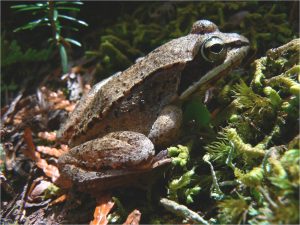Wood frog (Lithobates sylvaticus) populations in the Northeast are considered important indicators of long-term forest and ecosystem health. These frogs are vulnerable because they rely on vernal pools for several stages of their life cycle. Although this species has limited species-specific studies, it has been identified by experts as an increasingly important indicator. Population metrics can be used to predict future trends in wood frog populations.

There are 7 protocols that are used to monitor the indicator: Amphibians: Wood Frog. The first three studies on the list below are the most common methods of monitoring in the Northeast region.
The impacts of climate indicators can be measured using different ecological metrics of quantification. The metrics used in a study can affect how it is designed and the questions that it can answer. The information below shows the types of metrics and number of associated protocols that are captured by the data represented in this project.